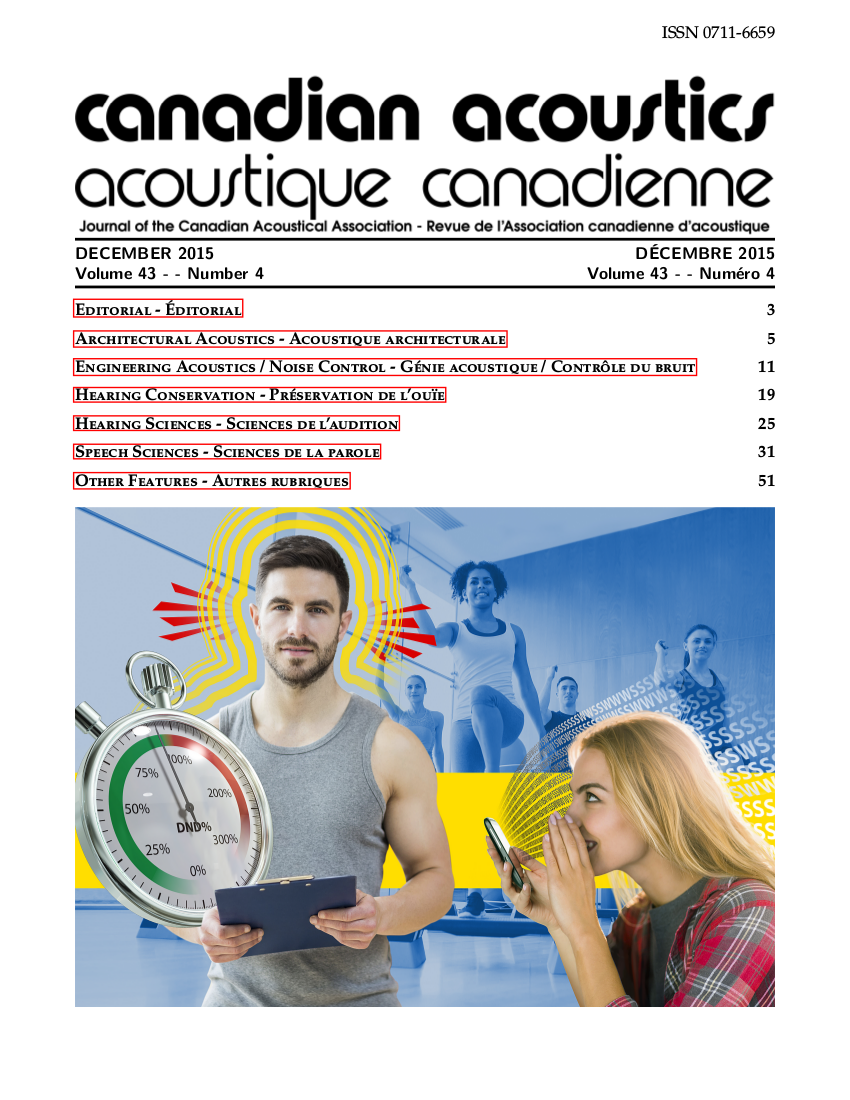Impact of Auditory Attention on the Efferent Auditory System in the Absence of Real Auditory Targets
Mots-clés :
attention auditive, attention visuelle, inhibition controlatérale, otoémissions acoustiques provoquées, efférentRésumé
La comparaison de l'attention visuelle et auditive à des conditions sans-tâches a démontré une modulation du système efférent auditif dépendante de l’attention (De Boer & Thornton, 2007; Maison, Micheyl, & Collet, 2001). Cependant, il reste à déterminer si ces effets résultent de processus attentionnels généralisés ou de modalités. Dans cette étude, 16 jeunes adultes ont observé les mouvements du visage lors de la parole liés à la production des voyelles /a/ et /u/ en présence de bruit à bande large (BBN) controlatérale sous deux directives: (a) comptage visuel du nombre de production du /a/ en ignorant le BBN (attention visuelle) et (b) écoute soigneuse et comptage des sons cibles /a/ intégrés dans le BBN (condition feinte; attention auditive). Ces essais « feints » n'avaient pas de cibles acoustiques et reflètent l'effet de l'attention auditive en absence de véritables cibles auditives. L'influence de l'attention visuelle et auditive sur le système efférent auditif est mesurée par la inhibition controlatérale des otoémissions acoustiques provoquées (OEAP; Collet, Chanel, & Morgon, 1990). Les changements moyens du niveau de base pour l'attention visuelle et pour l'attention auditive sont respectivement de 2.19 et 1.88 dB SPL. La différence moyenne entre les deux conditions entraîne un effet positif modéré avec un d de Cohen de 0.52. Douze des seize participants (75%; valeur p du test binomial (unilatéral)= 0.03*) ont démontré une inhibition plus grande des amplitudes d’OEAPs (différence moyenne = 0.31 dB SPL) en condition d'attention visuelle qu’en condition d'attention auditive. Nos résultats démontrent que ces effets peuvent être obtenus même en absence de véritables cibles auditives. En résumé, l’observation d’une différence dans la inhibition de OEAPs entre les conditions d'attention visuelle et auditive fournit des preuves préliminaires soutenant une modulation attentionnelle spécifique plutôt qu'une modulation attentionnelle généralisée dans le système efférent auditif.
Fichiers supplémentaires
Publié-e
Comment citer
Numéro
Rubrique
Licence
Author Licensing Addendum
This Licensing Addendum ("Addendum") is entered into between the undersigned Author(s) and Canadian Acoustics journal published by the Canadian Acoustical Association (hereinafter referred to as the "Publisher"). The Author(s) and the Publisher agree as follows:
-
Retained Rights: The Author(s) retain(s) the following rights:
- The right to reproduce, distribute, and publicly display the Work on the Author's personal website or the website of the Author's institution.
- The right to use the Work in the Author's teaching activities and presentations.
- The right to include the Work in a compilation for the Author's personal use, not for sale.
-
Grant of License: The Author(s) grant(s) to the Publisher a worldwide exclusive license to publish, reproduce, distribute, and display the Work in Canadian Acoustics and any other formats and media deemed appropriate by the Publisher.
-
Attribution: The Publisher agrees to include proper attribution to the Author(s) in all publications and reproductions of the Work.
-
No Conflict: This Addendum is intended to be in harmony with, and not in conflict with, the terms and conditions of the original agreement entered into between the Author(s) and the Publisher.
-
Copyright Clause: Copyright on articles is held by the Author(s). The corresponding Author has the right to grant on behalf of all Authors and does grant on behalf of all Authors, a worldwide exclusive license to the Publisher and its licensees in perpetuity, in all forms, formats, and media (whether known now or created in the future), including but not limited to the rights to publish, reproduce, distribute, display, store, translate, create adaptations, reprints, include within collections, and create summaries, extracts, and/or abstracts of the Contribution.


